The Camargue, Saintes-Maries-De-La-Mer, Provence
Zagan the motorhome is in the Camargue, the central part of which is a huge nature reserve on the south coast of France. On the map we’re east of Montpellier, and are sat in an enormous estuary between the final arms of the mighty Rhône river, formed by a split to the north, before reaching the sea. We’re in one of several aires provided for motorhomes around the unofficial capital of the Camargue, Saintes-Maries-De-La-Mer. We picked this one as it’s facing the Med, and is located midway between the town and one of the entrances to the marshes (N43.45399, W4.43827). The nature reserve proper is 5km away, but the captivating sight of a small mixed horde of fish-stabbing birds is just a short stroll away.
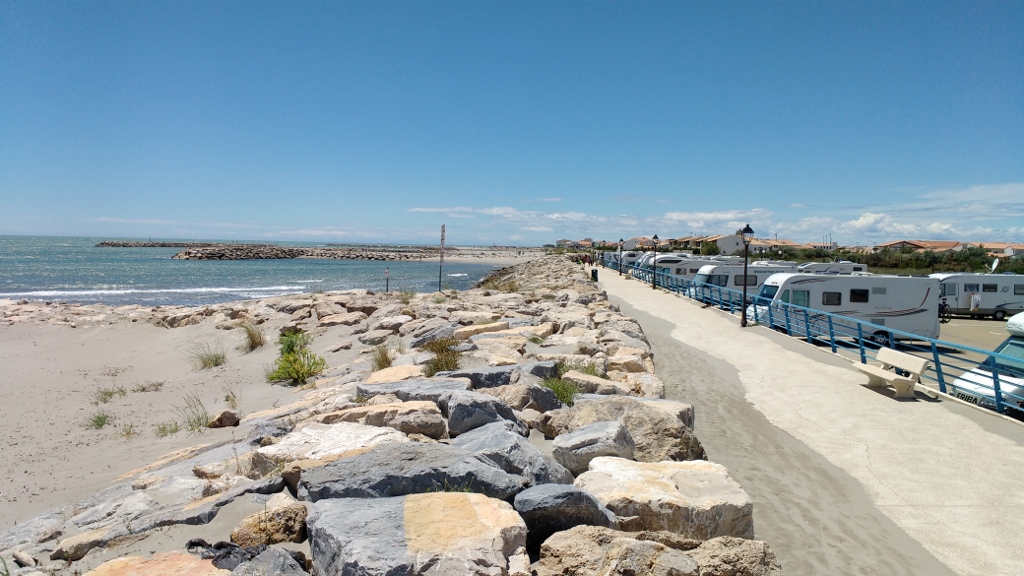
One of several motorhome aires at Saintes-Marie-De-La-Mer, Camargue
It costs €13 a day to stay here, which isn’t cheap by French aire standards, but is the going rate for being on the coast in Le Midi (what the French call the south). That will be especially true in August, when the French go on holiday en masse, and prices go up en masse, but we’ll be back home in sunny England (:-)) by the time the hunt-a-space fun starts here. €13 feels great value to us, being in such a great location. If you want to, you can also drive another 500m away from the town to a second part of the aire, which is practically in the marshes.
Our route here took us into the Gard department (famous in part for the beautiful Pont du Gard Roman aqueduct), and past Aigues-Morte, a walled medieval town which features large in the tourist press. The photos of the place looked impressive, but the closest we got was a Lidl on the outskirts to top up with fresh food. Why not pop in to the town? Laziness gave it the thumbs down, if I’m 100% honest. Trying to find somewhere to park which felt safe, not wanting to leave Charlie in a hot van (he won’t walk far these days) and an over-active imagination into the likely tourist tat shops we might find bounced us off the outskirts and onto our destination proper: here.
A mid-route debate took place as we rounded in on the reserve. The satnav was planned for a free, France Passion style stop off towards the north of the reserve. The place had 4 out of 5 stars and lots of reviews, while the various aires down here by the coast had maybe 3 stars. We opted to hit the coast and risk staying in a one-star dropper. After we’d arrived and looked around we determined the star was probably lost only because of the price; it looks pretty cool to us.
Once we’d settled ourselves in (winding the steadies down – the wind’s blowing a hoolie), we took a walk towards the nature reserve, and not getting far. The marshland’s long been claimed back from the sea to allow agriculture around the edges of it, with a 25 mile-long dyke (called a digue here). Sea water is only allowed in at certain points controlled with gates and Archimedes screws, and one of the nearby gates was in the process of allowing the sea to flow back in to the mudflats, concentrating small fish in a narrow channel. Above and alongside the water waited the hungry, white birds, stabbing heads or plunging entire bodies at the water, pulling out silvery flashes and gulping them down. It was a captivating sight, and a few people stood in silence, some with cameras a similar size to rocket launchers, observing the one-sided hunt. Further along the road a few dozen flamingos, their legs bent backwards as they stalked along, scooped at the shallow lake bed.
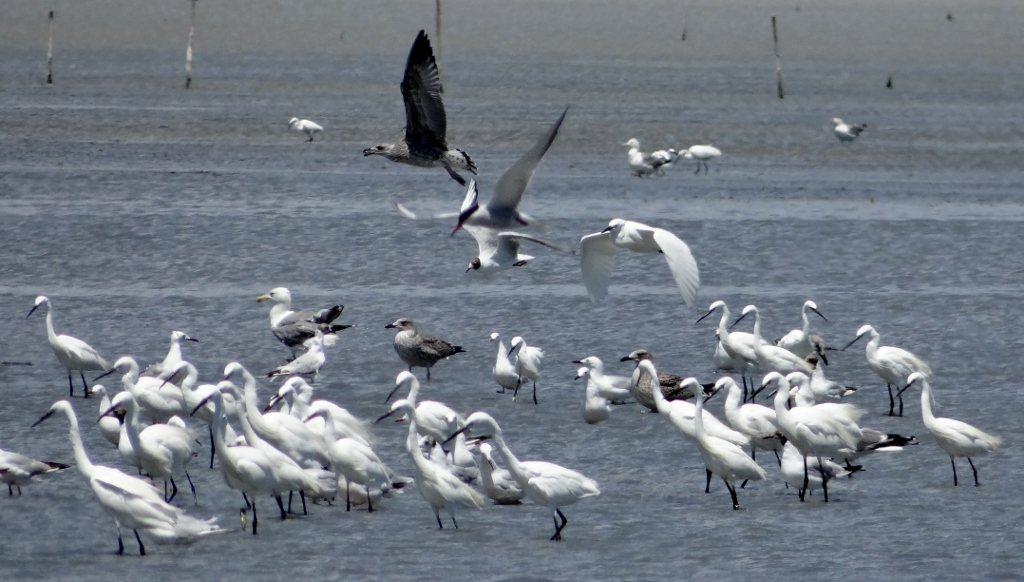

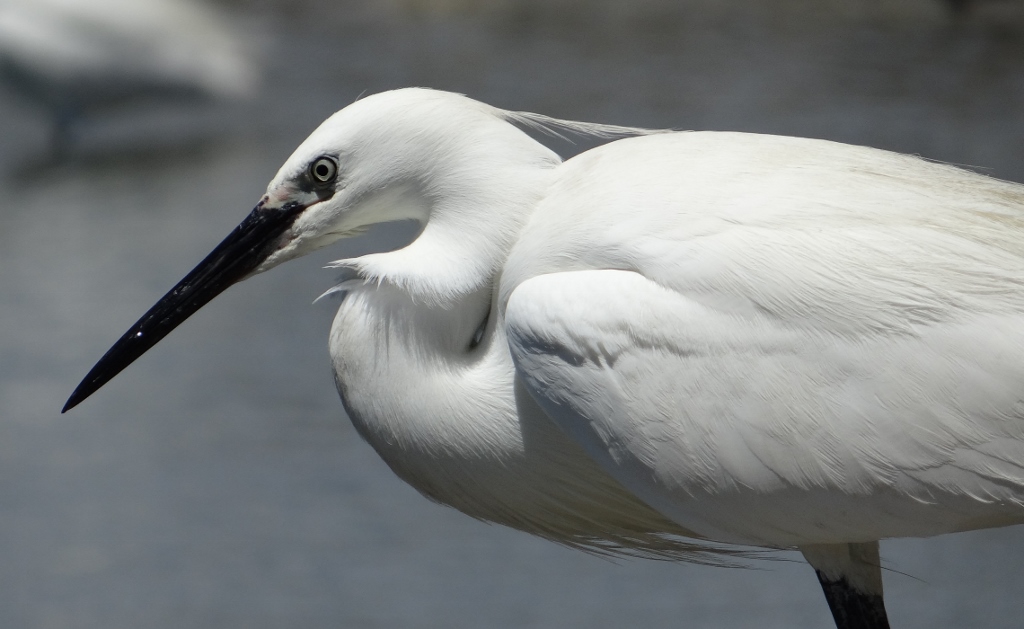
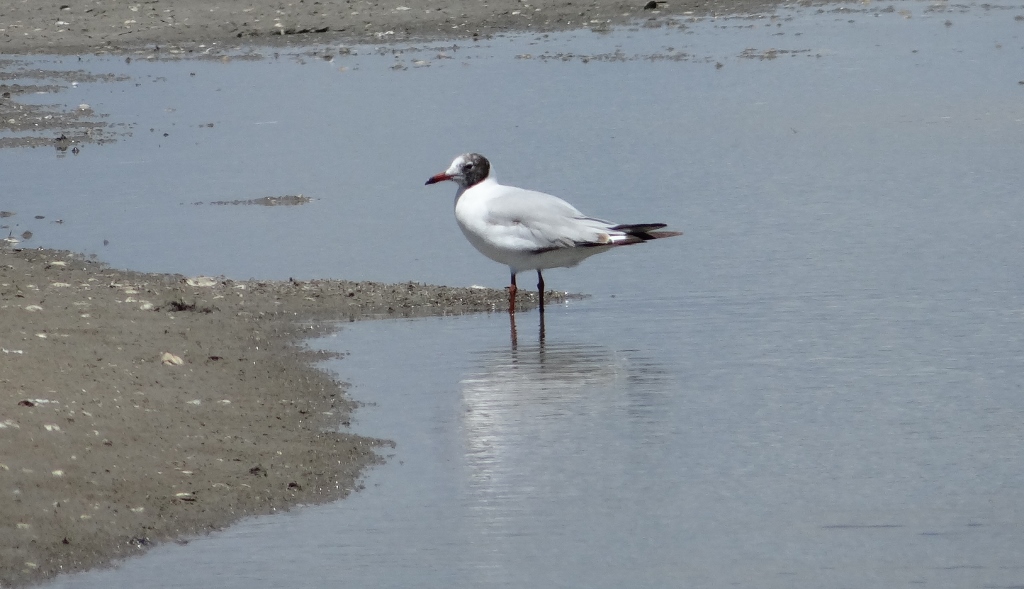

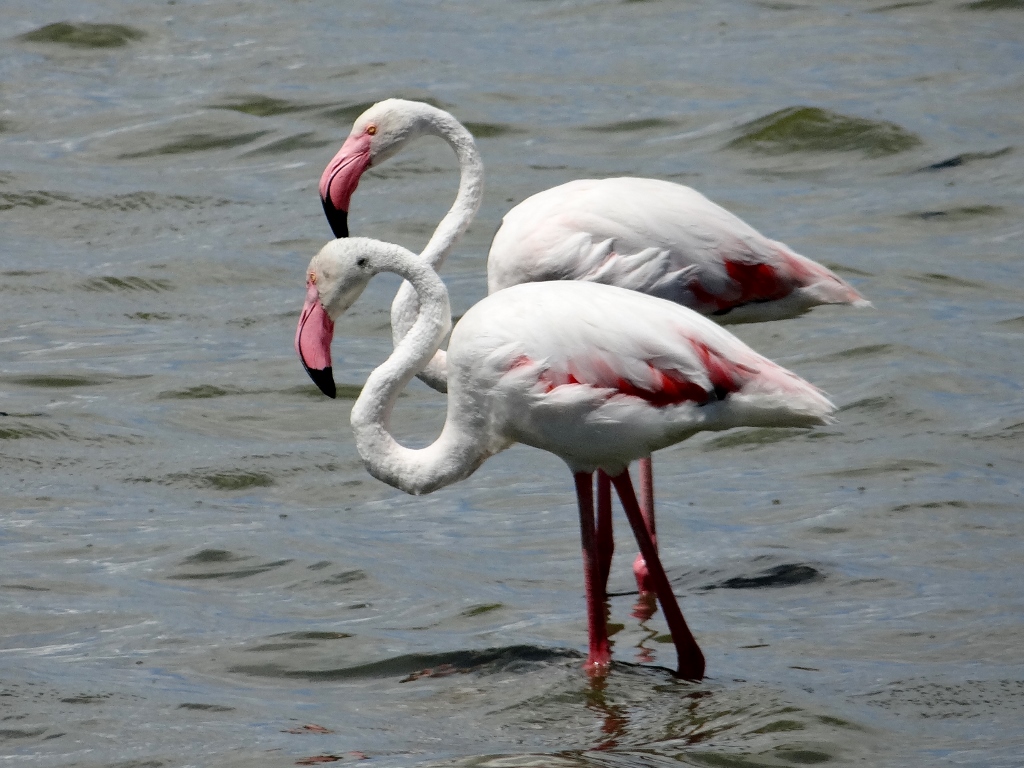
The Camargue’s also famous for sturdy horses and black bulls. The former, which turn white as they mature, are apparently never stabled, despite the harsh conditions down here. Never-the-less, dozens of stables provide horses for us tourists to calmly amble through the marshes along pre-defined routes. From the road on the way here we spotted a few horses which appeared half-wild, keeping well back from the fences, but not exactly legging it about like Black Beauty.
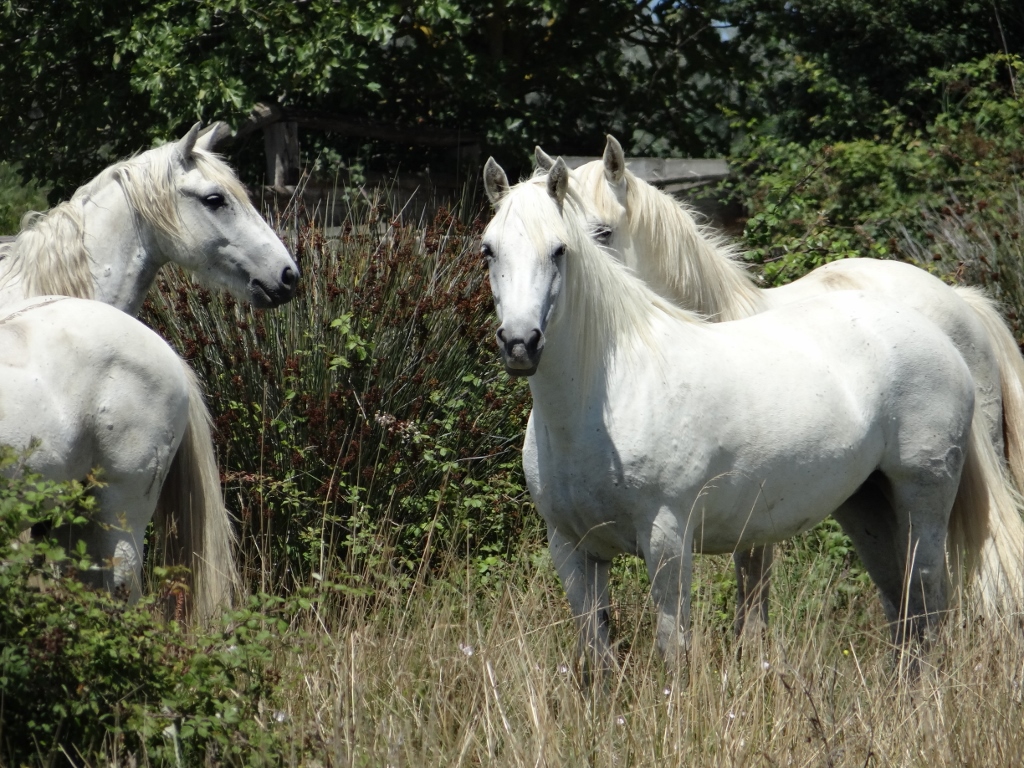
The bulls remain elusive, we’ve not spotted any yet, but they are raised here for a type of bull fighting in local French arenas. Unlike the Spanish fights, where the bulls are almost always killed, they’re not physically harmed in these local ‘fights’. Instead the bulls are wound up to the point they’ll chase raseteurs – blokes legging it across the arena and trying to grab a ribbon from the bull’s horns (more information here).
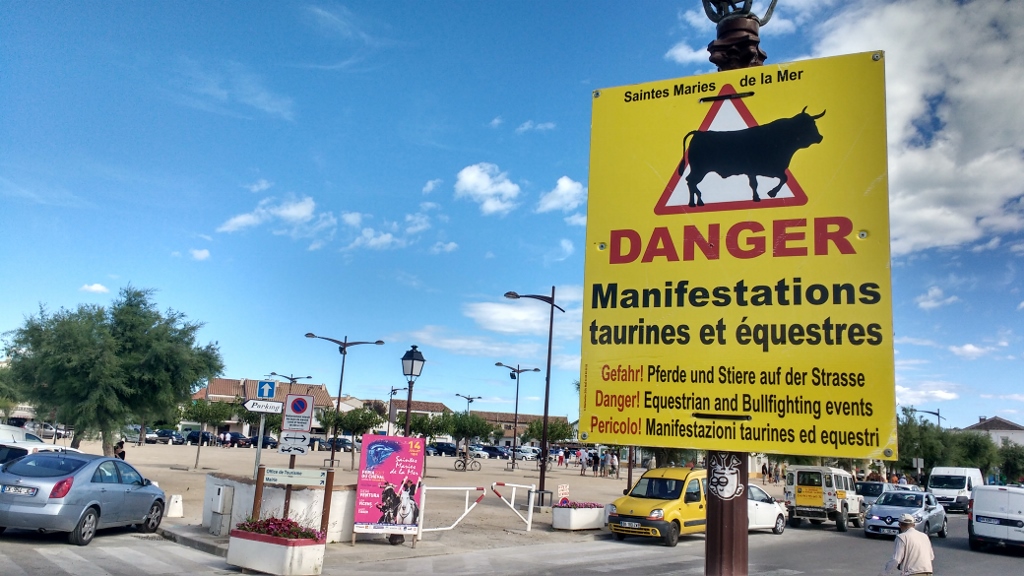
A warning sign in Saintes-Maries-De-La-Mer.
Wandering down the boardwalk into the town itself, the place was well alive with the well-heeled. It comes across as a reasonably upmarket (to me!) seaside destination, heaving with restaurants and cafes selling mussels, oysters, snails and fish. Legend has is that three Saint Marys of Biblical times, having witnessed the resurrection of Jesus, sailed from Egypt and ended up here – feasible since both are on the same big puddle of water – the Med – but there seems to be little actual evidence to support it.
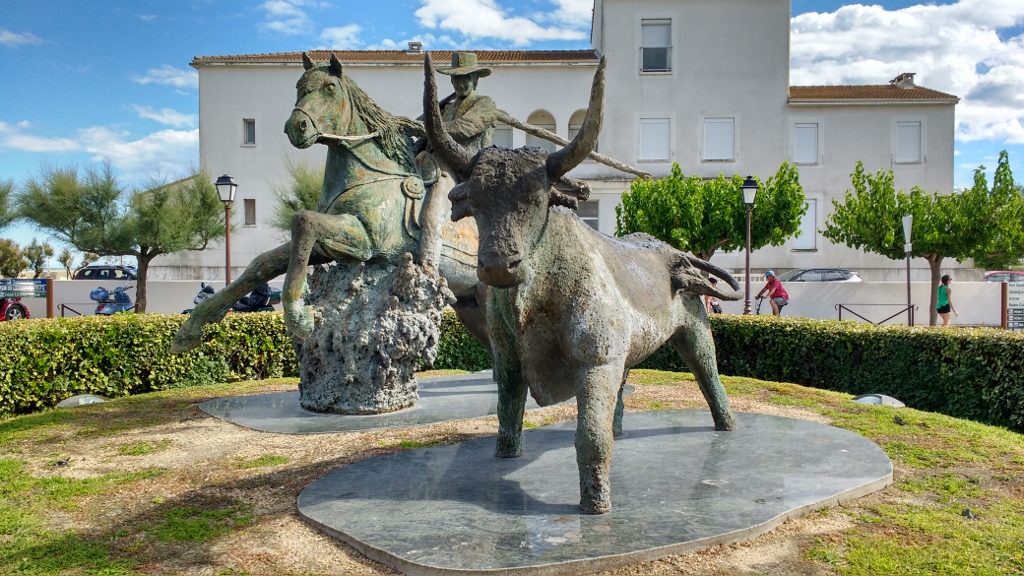
A Camargue cowboy at work in Saintes-Maries-de-la-Mer
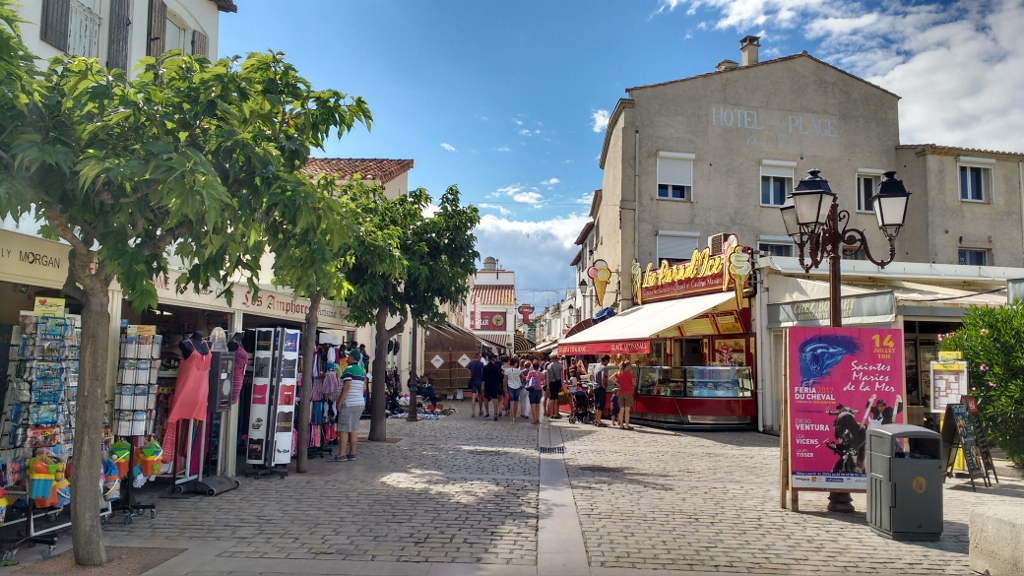
The only ‘sight’ as such that we saw was the Romanesque church, a fortified thing which once helped secure the locals against Saracen raiders. Inside, past the bits of bones of saints, stands a chest-high dark skinned Saint Sarah – a possible Egyptian servant of the Marys (again according to legend). French Roma use Sarah as the focus of a big festival in May, and folks were stood either side of the model woman getting photos taken with her, clearly a famous icon.
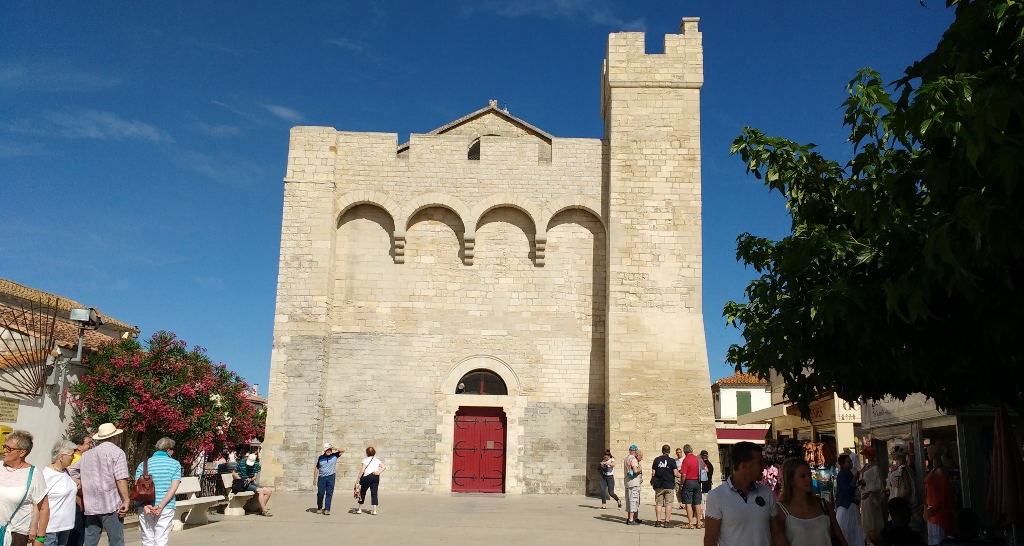
The church at Saintes-Maries-de-la-Mer
This morning we’ve both made forays out along the dyke and into the park. Ju put in a 10km run and I shoved my butt and bike along about 40km in vain search of the bulls. The wind’s really up. The sun’s hammering down. There are no birds to be seen, and few tourists out on the paths, but on the plus side the last famous resident of the Camargue – the ravenous mosquitoes – aren’t here either!
We’re holed up in the van a while now as the afternoon cools off, then we’ll make another trip into town. There are a fair few Italian motorhomes in the aire with us (we’re not that far from Italy here), and a fair few Italian gelato shops await, serving up a hundred flavours of ice cream for us to have a go at. North of us lies Provence, and then the Alps. We’ve seen a few of Provence’s delights in the past – Nîmes (before the motorhome), the Pont du Gard, the Gorges du Verdon, Mont Ventoux, Fontaine-de-Vaucluse – we need to get the map out, as ever, and plan our way north through new places.
Cheers, Jay

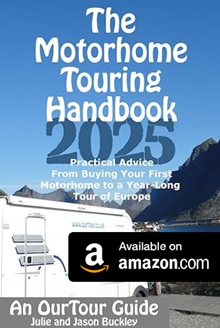

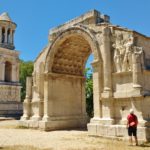
Hi – we stayed at that aire last June and quite liked it. Aigues-Mortes is a pretty little town with far fewer tat shops than we expected (unlike Carcassonne) we even sat in the central square with an ice cream!
There is a generous safe area for moho parking but you are right, there would have been nowhere to park the van that would shade it enough for Charlie to be comfortable. We don’t take our elderly (14) Labrador with us but wouldn’t have left him there – sun/heat rather than safety.
Ann
PS – excuse the we site, I’m still learning!
From a Fr. Passion place close to Nîmes we visited this beautiful place by bus.
St Rémy de Provence offers a free overnight car park Avenue Pierre Barbier, next to an arena, ask tourist office if still ok in July. We spent a couple of nights in October. Smack in the middle of town, oh, well, 5′ walk. And you can visit/see the archeological site Glanum from a walk, no need to pay to go in.
les Baux de Provence, also worthwhile but long ago we visited. Enjoy!!!
Our favourite spot. Last two autumns so I can finish my novel(s). We’ll be back there in October. Thanks for the memory.